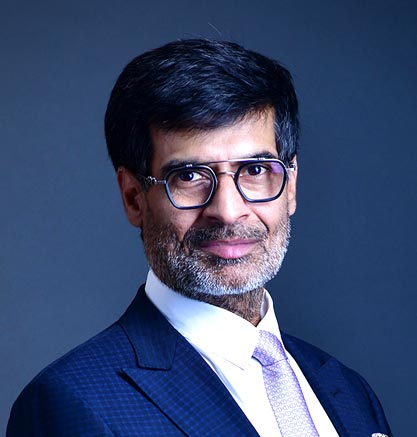-
CENTRES
Progammes & Centres
Location
Innovative approaches will require regulatory processes to include all stakeholders.

Technology has long shaped the contours of geopolitical relations – parties competed to outinnovate their opponents in order to build more competitive economies, societies and militaries. Today is different. With breakthroughs in frontier technologies manifesting at rapid rates, the question is not who will capture their benefits first but how parties can work together to promote their beneficial use and limit their risks.
The prolific pace of advancement of frontier technologies – artificial intelligence (AI), quantum science, blockchain, 3D printing, gene editing and nanotechnology, to name a few – and its pursuit by a multitude of state and non-state actors, with varied motivations, has opened a new chapter in contemporary geopolitics. For state actors, these technologies offer a chance to gain strategic and competitive advantage, while for malicious nonstate actors, these technologies present another avenue to persist with their destabilizing activities.
Therefore, emerging technologies have added another layer to a fragmented and contested global political landscape. Besides shaping geopolitical dynamics, they are also transforming commonly held notions of power – by going beyond the traditional parameters of military and economic heft to focus on states’ ability to control data and information or attain a tech breakthrough as the primary determinant of a state’s geopolitical influence.
These technologies also have significant socioeconomic implications. By some estimates, generative AI could add the equivalent of $2.6 trillion to $4.4 trillion to the global economy and boost labour productivity by 0.6% annually through 2040.14 Yet, simultaneously, the rapid deployment of these technologies has sparked concerns about job displacement and social disruption. These dynamics are triggering new geopolitical alignments as states seek to cooperate or compete in developing and using new technologies.
As frontier technologies take centre stage in global politics, they present a new challenge for international diplomacy.
As frontier technologies take centre stage in global politics, they present a new challenge for international diplomacy. What can states do to stem the proliferation of frontier dual-use technologies in the hands of malicious actors who intend to cause harm? Can states look beyond their rivalries to conceive out-of-the-box solutions, or will they always be playing a catch-up game with tech advancements? What role behoves the United Nations-led multilateral frameworks regarding the global governance of these technologies, or will plurilateralism and club-lateralism trump it?
The historical evolution of global tech regimes offers important lessons for the challenges posed by frontier technologies today. During the Cold War, industrialized nations established export control regimes, such as the Nuclear Suppliers Group and the Missile Technology Control Regime, that sought to exclude certain countries by denying them several dual-use technologies. Those control regimes proved successful in curbing tech proliferation. However, with changing geopolitical realities, the same regimes began extending membership to previously excluded countries. This approach offers a vital lesson: shedding the initial exclusivist approach in favour of extending membership helped to retain the regimes’ legitimacy.
Secondly, while the multilateral export control regimes succeeded, the nuclear non-proliferation regimes performed sub-optimally as they amplified the gap between nuclear haves and have-nots. This triggered resentment from the nuclear have-nots, who sought to chip away at the legitimacy of the regimes.
The key lesson for today is that the success of any tech-related proliferation control efforts is contingent on not accentuating existing technology divisions between the Global North and South.
The UN-led multilateral framework has focused on enhancing global tech cooperation through initiatives like the Secretary-General’s High-level Panel on Digital Cooperation. However, while there has been little substantive progress at the global, multilateral level, bilateral and minilateral tech cooperation has thrived. Groupings such as the Quad, AUKUS and I2U2 that focus on niche tech cooperation present a possible model pathway forward.15 They have demonstrated the value of like-minded partners coming together to realise a common vision and ambition. These arrangements also suggest that even as the UN-led multilateral frameworks attempt to grapple with frontier technologies, minilaterals may provide the starting point for collaboration to address frontier technologies’ advancement.
To ensure that efforts at tech regulation succeed, countries will be required to undertake innovation in policy-making, where governments take on board all the stakeholders – tech corporations, civil society, academia and the research community. The challenge posed in recent months by generative AI through tools like deep fakes and natural language processing models like ChatGPT has shown that unless these stakeholders are
integrated into policy design, regulations will always be afterthoughts.
The following are four proposals for strengthening global cooperation on frontier technologies:
- Develop the Responsibility to Protect (R2P) framework for emerging technologies: Similar to the R2P framework developed by the UN for protecting civilians from genocide, war crimes, ethnic cleansing and crimes against humanity, the international community must create a regulatory R2P obligation for states to protect civilians from the harms of emerging technologies. This obligation would entail three pillars: 1) the responsibility of each state to protect its populations from the emerging technologies’ misuse, 2) the responsibility of the international community to assist states in protecting their populations from the emerging technologies’ misuse, and 3) the responsibility of the international community to take collective action to protect populations when a state is manifestly failing to protect its own people from the emerging technologies’ misuse. The specific measures that are needed will vary depending on the specific technologies involved and the risks that they pose.
- Design a three-tier “innovation to market” roadmap: States must ensure responsible commercial application and dispersion of new technologies. One critical step towards this is for states to design a three-tiered tech absorption framework comprising a regulatory sandbox (pilot tested in a controlled regulatory environment for assessing collateral impact), city-scale testing and commercial application.
- Convene a standing Conference of the Parties for future tech: The Global South must convene a standing Conference of the Parties (COP) for future technologies along the lines of COP for climate change negotiations. This body would meet on an annual basis where the multistakeholder community – national governments, international organizations and tech community – will deliberate on new tech developments, present new innovations and reflect on related aspects of the dynamic tech ecosystem and its engagement with the society and communities.
- Link domestic innovation ecosystems: Inter-connected national innovation ecosystems will ensure that like-minded countries can pool their finite financial, scientific and technological human resources to develop technologies. For instance, in the field of quantum science, the European Commission’s research initiative, the Quantum Flagship, has partnered with the United States, Canada and Japan through the InCoQFlag project. Likewise, the Quad has the Quad Center of Excellence in Quantum Information Sciences. This underlines the importance of prioritizing one of the frontier technologies and networking domestic innovation ecosystems to focus on its development, as no country alone can harness the deep potential of frontier technologies and mitigate the associated risks.
Throughout history, technology has been the currency of geopolitics. New innovations have bolstered economies and armies, strengthening power and influence. Yet, technology has also served as an opportunity to bind parties closer together. Today, at a time of heightened geopolitical risks, it is incumbent on leaders to pursue frameworks and ecosystems that foster trust and cooperation rather than division.
This essay is a part of report Shaping Cooperation in a Fragmenting World.
The views expressed above belong to the author(s). ORF research and analyses now available on Telegram! Click here to access our curated content — blogs, longforms and interviews.

Samir Saran is the President of the Observer Research Foundation (ORF), India’s premier think tank, headquartered in New Delhi with affiliates in North America and ...
Read More +
Flavia Alves is the Head of International Institutions and Relations at Meta. She obtained her International Masters of Law (LL.M) degree from American University, and ...
Read More +
Vera Songwe is the Founder and Chair of Liquidity and Sustainability Facility. A repo facility for emerging countries. She is also the co-chair of the High ...
Read More +